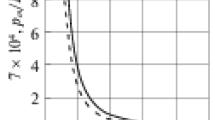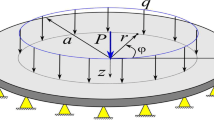Conclusions
-
1.
When a flexible circular plate, freely supported along the perimeter and loaded by an axial force applied at the center, is subjected to bending, then the surfaces on which σR and σθ are equal to zero lie inside the plate and do not coincide with each other or with the middle surface of the plate.
-
2.
In the case of bending of a thin plate or a plate of medium thickness, the peripheral stresses σϕ along the generatrices of the hole on the surface of the plate have the same sign, and this coincides with the sign of the bending stresses on that surface.
-
3.
In a thin plate (K=2.7) the maximal stresses arise at the points 1 (5) of the perimeter of the hole lying on the tensioned surface of the plate, in a plate of medium thickness (K=2.4) at the points 3 and 7 of the perimeter of the hole lying on the compressed surface of the plate.
Similar content being viewed by others
Literature Cited
Strength. Stability. Vibrations (Handbook) [in Russian], Vol. 1, Mashinostroenie, Moscow (1968).
S. P. Timoshenko and S. Voinovskii-Kriger, Plates and Shells [in Russian], Nauka, Moscow (1966).
Additional information
Kiev University. Translated from Problemy Prochnosti, No. 7, pp. 99–101, July, 1987.
Rights and permissions
About this article
Cite this article
Nakonechnyi, V.V. Bending of a circular plate with eccentric hole. Strength Mater 19, 994–998 (1987). https://doi.org/10.1007/BF01523544
Received:
Issue Date:
DOI: https://doi.org/10.1007/BF01523544




